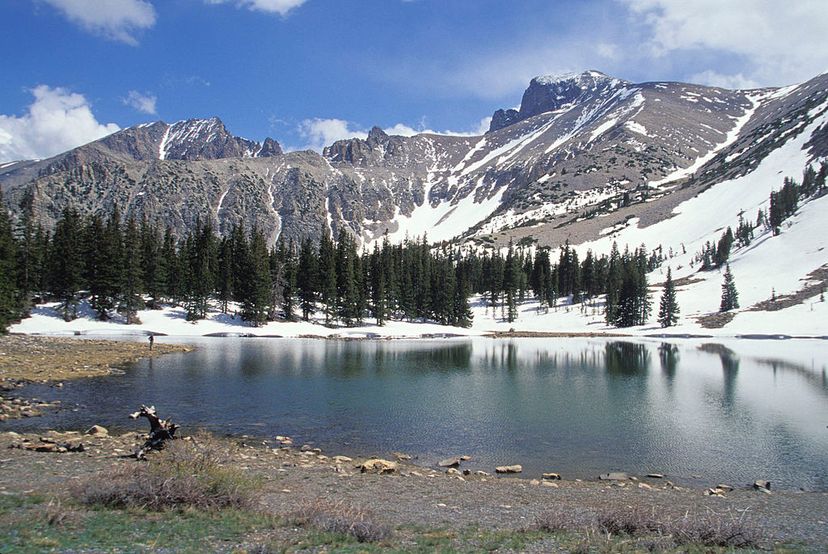
Advertisement
Stunning Marble Caves under the Starriest Night Skies
In east-central Nevada lies Great Basin National Park, with forests of bristlecone pines, beautiful caves, and one of the clearest night skies you’ll ever experience.
Advertisement
Activities in Great Basin National Park
Tour the Lehman Caves. These beautiful marble caves are ornate with stalactites, stalagmites, and helictites, and can only be experienced with a tour guide. One of the most popular tours is the one-hour Candlelight Tour, in which visitors explore the cave using historic candle lanterns to lead the way. This tour follows the Lodge Room Tour route. Regardless of what tour they’ve signed up for, visitors are allowed to bring very few items with them into the cave: a jacket, a camera, and a flashlight.
The park is also well-known for its hiking, with more than 60 developed trails. Since many of the park’s trails are at high elevations, hiking is typically only done from June through September. The park highly recommends that visitors stay on the trail if there is one since the alpine ecosystem is fragile and can be easily damaged.
One of the most popular trails is the Wheeler Summit Trail. This trail is for the experienced backcountry hiker. Because of the high risk of afternoon storms, this trail should be started early in the morning. The trail leads visitors 8.6 miles to the Wheeler Peak summit. Visitors should be wary that the final 1,000 feet to the summit are very steep, but the top provides stunning views of the park and wildlife.
Advertisement
Visiting Great Basin National Park
There park charges no entrance fee, but cave tours can cost up to $10 per person.
Summer is the most popular season to visit, but the park is open year-round, as is the Lehman Caves Visitor Center. The Great Basin Visitor Center is open from May through September. If you plan on visiting in the summer and want to lodge, it is best to make reservations in the town of Baker, Nevada, which is five miles outside the park.
The park’s scenic drive is paved, and most of it is open year-round. The upper portion of the road is usually only open June through October, depending on the weather. During the summer, most of the roads are open. It is a good idea to check current road conditions before visiting. The most common causes of accidents on these roads are drowsiness and speeding. When driving through western Utah and eastern Nevada, it is not uncommon to drive 100 miles to the next gas station or grocery store.
Advertisement
Wildlife in Great Basin National Park
Great Basin National Park is rich in wildlife. One of the park’s most protected animals is the bat. Bats make up 20 percent of all mammals, but bat populations have declined in the last 40 years. Pesticides have been introduced into the bats’ food chain, and two-thirds of the bat population now use abandoned mine shafts as roosting spots. Many bats have been driven out of their caves by human recreational and commercial caving.
The Great Basin was once extensively mined, and that history has left behind many abandoned mine shafts containing possible explosives and poisonous gasses. Some entrances have been blasted closed or backfilled, which protects humans but is dangerous to the bats that have made the cavities their homes. The park is currently working on efforts to make the mine shafts safer. Bat out-flight surveys are performed before the mine is closed.
Advertisement
History of Great Basin National Park
The area now known as Great Basin National Park has been inhabited for thousands of years. One of the area’s most notable Native American tribes was the Fremont. The Fremont stood apart from the societies that preceded and succeeded them because of their unique artistic abilities. They made clay figurines, baskets, coiled pottery, and moccasins. The Fremont disappeared around the year 1500, and the ancestors of the Shoshoni, Ute, and Paiute peoples migrated into the area.
Absolem Lehman and his family were among the first Euro-American settlers. They made their living ranching and mining. It was he who first discovered the caves that now bear his name: Lehman Caves. In 1885 he conducted the first guided tour of the caves, which have since become a popular attraction at the park.
In the late 1800s to early 1900s the area was used by Basque sheepherders. Evidence of their presence is carved into the Aspen trees. Lonesome sheepherders would carve the date and their initials in the trees as a means of communication with the other herders.
Ranchers depended on the land of the Great Basin for generations. The area was established as Great Basin National Park in 1986, but most ranches operated until 1999 when the park service forced most of the ranchers to cease activity. The Snake Basin is the only area with ranchers today.
Other key dates in Great Basin National Park’s history
- 1922 – President Warren G. Harding creates Lehman Caves National Monument.
- 1964 – Prometheus, the oldest non-clonal tree ever discovered, is cut down near Wheeler Peak by a graduate student for research.
- 1986 – Great Basin National Park is established.
Advertisement